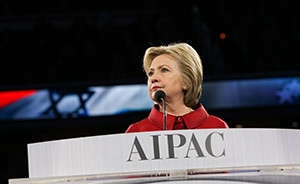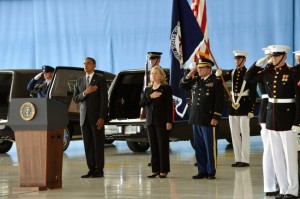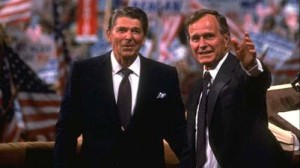Democrats Are Now the Aggressive War Party
Exclusive: For nearly a half century – since late in the Vietnam War – the Democrats have been the less warlike of the two parties, but that has flipped with the choice of war hawk Hillary Clinton, writes Robert Parry.
The Democratic Party has moved from being what you might call a reluctant war party to an aggressive war party with its selection of Hillary Clinton as its presumptive presidential nominee. With minimal debate, this historic change brings full circle the arc of the party’s anti-war attitudes that began in 1968 and have now ended in 2016.
Since the Vietnam War, the Democrats have been viewed as the more peaceful of the two major parties, with the Republicans often attacking Democratic candidates as “soft” regarding use of military force.

Former Secretary of State Hillary Clinton addressing the AIPAC conference in Washington D.C. on March 21, 2016. (Photo credit: AIPAC)
But former Secretary of State Clinton has made it clear that she is eager to use military force to achieve “regime change” in countries that get in the way of U.S. desires. She abides by neoconservative strategies of violent interventions especially in the Middle East and she strikes a belligerent posture as well toward nuclear-armed Russia and, to a lesser extent, China.
Amid the celebrations about picking the first woman as a major party’s presumptive nominee, Democrats appear to have given little thought to the fact that they have abandoned a near half-century standing as the party more skeptical about the use of military force. Clinton is an unabashed war hawk who has shown no inclination to rethink her pro-war attitudes.
As a U.S. senator from New York, Clinton voted for and avidly supported the Iraq War, only cooling her enthusiasm in 2006 when it became clear that the Democratic base had turned decisively against the war and her hawkish position endangered her chances for the 2008 presidential nomination, which she lost to Barack Obama, an Iraq War opponent.
However, to ease tensions with the Clinton wing of the party, Obama selected Clinton to be his Secretary of State, one of the first and most fateful decisions of his presidency. He also kept on George W. Bush’s Defense Secretary Robert Gates and neocon members of the military high command, such as Gen. David Petraeus.
This “Team of Rivals” – named after Abraham Lincoln’s initial Civil War cabinet – ensured a powerful bloc of pro-war sentiment, which pushed Obama toward more militaristic solutions than he otherwise favored, notably the wasteful counterinsurgency “surge” in Afghanistan in 2009 which did little beyond get another 1,000 U.S. soldiers killed and many more Afghans.
Clinton was a strong supporter of that “surge” – and Gates reported in his memoir that she acknowledged only opposing the Iraq War “surge” in 2007 for political reasons. Inside Obama’s foreign policy councils, Clinton routinely took the most neoconservative positions, such as defending a 2009 coup in Honduras that ousted a progressive president.
Clinton also sabotaged early efforts to work out an agreement in which Iran surrendered much of its low-enriched uranium, including an initiative in 2010 organized at Obama’s request by the leaders of Brazil and Turkey. Clinton sank that deal and escalated tensions with Iran along the lines favored by Israel’s right-wing Prime Minister Benjamin Netanyahu, a Clinton favorite.
Pumping for War in Libya
In 2011, Clinton successfully lobbied Obama to go to war against Libya to achieve another “regime change,” albeit cloaked in the more modest goal of establishing only a “no-fly zone” to “protect civilians.”
Libyan leader Muammar Gaddafi had claimed he was battling jihadists and terrorists who were building strongholds around Benghazi, but Clinton and her State Department underlings accused him of slaughtering civilians and (in one of the more colorful lies used to justify the war) distributing Viagra to his troops so they could rape more women.
Despite resistance from Russia and China, the United Nations Security Council fell for the deception about protecting civilians. Russia and China agreed to abstain from the vote, giving Clinton her “no-fly zone.” Once that was secured, however, the Obama administration and several European allies unveiled their real plan, to destroy the Libyan army and pave the way for the violent overthrow of Gaddafi.
Privately, Clinton’s senior aides viewed the Libyan “regime change” as a chance to establish what they called the “Clinton Doctrine” on using “smart power” with plans for Clinton to rush to the fore and claim credit once Gaddafi was ousted. But that scheme failed when President Obama grabbed the limelight after Gaddafi’s government collapsed.
But Clinton would not be denied her second opportunity to claim the glory when jihadist rebels captured Gaddafi on Oct. 20, 2011, sodomized him with a knife and then murdered him. Hearing of Gaddafi’s demise, Clinton went into a network interview and declared, “we came, we saw, he died” and clapped her hands in glee.
Clinton’s glee was short-lived, however. Libya soon descended into chaos with Islamic extremists gaining control of large swaths of the country. On Sept. 11, 2012, jihadists attacked the U.S. consulate in Benghazi killing Ambassador Christopher Stevens and three other American personnel. It turned out Gaddafi had been right about the nature of his enemies.
Undaunted by the mess in Libya, Clinton made similar plans for Syria where again she marched in lock-step with the neocons and their “liberal interventionist” sidekicks in support of another violent “regime change,” ousting the Assad dynasty, a top neocon/Israeli goal since the 1990s.
Clinton pressed Obama to escalate weapons shipments and training for anti-government rebels who were deemed “moderate” but in reality collaborated closely with radical Islamic forces, including Al Nusra Front (Al Qaeda’s Syrian franchise) and some even more extreme jihadists (who coalesced into the Islamic State).
Again, Clinton’s war plans were cloaked in humanitarian language, such as the need to create a “safe zone” inside Syria to save civilians. But her plans would have required a major U.S. invasion of a sovereign country, the destruction of its air force and much of its military, and the creation of conditions for another “regime change.”
In the case of Syria, however, Obama resisted the pressure from Clinton and other hawks inside his own administration. The President did approve some covert assistance to the rebels and allowed Saudi Arabia, Turkey and the Gulf states to do much more, but he did not agree to an outright U.S.-led invasion to Clinton’s disappointment.
Parting Ways
Clinton finally left the Obama administration at the start of his second term in 2013, some say voluntarily and others say in line with Obama’s desire to finally move ahead with serious negotiations with Iran over its nuclear program and to apply more pressure on Israel to reach a long-delayed peace settlement with the Palestinians. Secretary of State John Kerry was willing to do some of the politically risky work that Clinton was not.

President Barack Obama and Secretary of State Hillary Clinton honor the four victims of the Sept. 11, 2012, attack on the U.S. mission in Benghazi, Libya, at the Transfer of Remains Ceremony held at Andrews Air Force Base, Joint Base Andrews, Maryland, on Sept. 14, 2012. [State Department photo)
A major testing moment for Obama came in August 2013 after a sarin gas attack outside Damascus, Syria, that killed hundreds of Syrians and that the State Department and the mainstream U.S. media immediately blamed on the forces of Syrian President Bashar al-Assad.
There was almost universal pressure inside Official Washington to militarily enforce Obama’s “red line” against Assad using chemical weapons. Amid this intense momentum toward war, it was widely assumed that Obama would order a harsh retaliatory strike against the Syrian military. But U.S. intelligence and key figures in the U.S. military smelled a rat, a provocation carried out by Islamic extremists to draw the United States into the Syrian war on their side.
At the last minute and at great political cost to himself, Obama listened to the doubts of his intelligence advisers and called off the attack, referring the issue to the U.S. Congress and then accepting a Russian-brokered deal in which Assad surrendered all his chemical weapons though continuing to deny a role in the sarin attack.
Eventually, the sarin case against Assad would collapse. Only one rocket was found to have carried sarin and it had a very limited range placing its firing position likely within rebel-controlled territory. But Official Washington’s conventional wisdom never budged. To this day, politicians and pundits denounce Obama for not enforcing his “red line.”
There’s little doubt, however, what Hillary Clinton would have done. She has been eager for a much more aggressive U.S. military role in Syria since the civil war began in 2011. Much as she used propaganda and deception to achieve “regime change” in Libya, she surely would have done the same in Syria, embracing the pretext of the sarin attack – “killing innocent children” – to destroy the Syrian military even if the rebels were the guilty parties.
Still Lusting for War
Indeed, during the 2016 campaign – in those few moments that have touched on foreign policy – Clinton declared that as President she would order the U.S. military to invade Syria. “Yes, I do still support a no-fly zone,” she said during the April 14 debate. She also wants a “safe zone” that would require seizing territory inside Syria.

Israeli Prime Minister Benjamin Netanyahu speaking to a joint session of the U.S. Congress on March 3, 2015, in opposition to President Barack Obama’s nuclear agreement with Iran. (Screen shot from CNN broadcast)
But no one should be gullible enough to believe that Clinton’s invasion of Syria would stop at a “safe zone.” As with Libya, once the camel’s nose was into the tent, pretty soon the animal would be filling up the whole tent.
Perhaps even scarier is what a President Clinton would do regarding Iran and Ukraine, two countries where belligerent U.S. behavior could start much bigger wars.
For instance, would President Hillary Clinton push the Iranians so hard – in line with what Netanyahu favors – that they would renounce the nuclear deal and give Clinton an excuse to bomb-bomb-bomb Iran?
In Ukraine, would Clinton escalate U.S. military support for the post-coup anti-Russian Ukrainian government, encouraging its forces to annihilate the ethnic Russian rebels in eastern Ukraine and to “liberate” the people of Crimea from “Russian aggression” (though they voted by 96 percent to leave the failed Ukrainian state and rejoin Russia)?
Would President Clinton expect the Russians to stand down and accept these massacres? Would she take matters to the next level to demonstrate how tough she can be against Russian President Vladimir Putin whom she has compared to Hitler? Might she buy into the latest neocon dream of achieving “regime change” in Moscow? Would she be wise enough to recognize how dangerous such instability could be?
Of course, one would expect that all of Clinton’s actions would be clothed in the crocodile tears of “humanitarian” warfare, starting wars to “save the children” or to stop the evil enemy from “raping defenseless girls.” The truth of such emotional allegations would be left for the post-war historians to try to sort out. In the meantime, President Clinton would have her wars.
Having covered Washington for nearly four decades, I always marvel at how selective concerns for human rights can be. When “friendly” civilians are dying, we are told that we have a “responsibility to protect,” but when pro-U.S. forces are slaughtering civilians of an adversary country or movement, reports of those atrocities are dismissed as “enemy propaganda” or ignored altogether. Clinton is among the most cynical in this regard.
Trading Places
But the larger picture for the Democrats is that they have just adopted an extraordinary historical reversal whether they understand it or not. They have replaced the Republicans as the party of aggressive war, though clearly many Republicans still dance to the neocon drummer just as Clinton and “liberal interventionists” do. Still, Donald Trump, for all his faults, has adopted a relatively peaceful point of view, especially in the Mideast and with Russia.
While today many Democrats are congratulating themselves for becoming the first major party to make a woman the presumptive nominee, they may soon have to decide whether that distinction justifies putting an aggressive war hawk in the White House. In a way, the issue is an old one for Democrats, whether “identity politics” or anti-war policies are more important.
At least since 1968 and the chaotic Democratic convention in Chicago, the party has advanced, sometimes haltingly, those two agendas, pushing for broader rights for all and seeking to restrain the nation’s militaristic impulses.
In the 1970s, Democrats largely repudiated the Vietnam War while the Republicans waved the flag and equated anti-war positions with treason. By the 1980s and early 1990s, Ronald Reagan and George H.W. Bush were making war fun again – Grenada, Afghanistan, Panama and the Persian Gulf, all relatively low-cost conflicts with victorious conclusions.
By the 1990s, Bill Clinton (along with Hillary Clinton) saw militarism as just another issue to be triangulated. With the Soviet Union’s collapse, the Clinton-42 administration saw the opportunity for more low-cost tough-guy/gal-ism – continuing a harsh embargo and periodic air strikes against Iraq (causing the deaths of a U.N.-estimated half million children); blasting Serbia into submission over Kosovo; and expanding NATO to the east toward Russia’s borders.
But Bill Clinton did balk at the more extreme neocon ideas, such as the one from the Project for the New American Century for a militarily enforced “regime change” in Iraq. That had to wait for George W. Bush in the wake of the 9/11 attacks. As a New York senator, Hillary Clinton made sure she was onboard for war on Iraq just as she sided with Israel’s pummeling of Lebanon and the Palestinians in Gaza.
Hillary Clinton was taking triangulation to an even more acute angle as she sided with virtually every position of the Netanyahu government in Israel and moved in tandem with the neocons as they cemented their control of Washington’s foreign policy establishment. Her only brief flirtation with an anti-war position came in 2006 when her political advisers informed her that her continued support for Bush’s Iraq War would doom her in the Democratic presidential race.
But she let her hawkish plumage show again as Obama’s Secretary of State from 2009 to 2013 – and once she felt she had the 2016 Democratic race in hand (after her success in the southern primaries) she pivoted back to her hard-line positions in full support of Israel and in a full-throated defense of her war on Libya, which she still won’t view as a failure.
The smarter neocons are already lining up to endorse Clinton, especially given Donald Trump’s hostile takeover of the Republican Party and his disdain for neocon strategies that he views as simply spreading chaos around the globe. As The New York Times has reported, Clinton is “the vessel into which many interventionists are pouring their hopes.”
Robert Kagan, a co-founder of the neocon Project for the new American Century, has endorsed Clinton, saying “I feel comfortable with her on foreign policy. If she pursues a policy which we think she will pursue it’s something that might have been called neocon, but clearly her supporters are not going to call it that; they are going to call it something else.” [See Consortiumnews.com’s “Yes, Hillary Clinton Is a Neocon.”]
So, by selecting Clinton, the Democrats have made a full 360-degree swing back to the pre-1968 days of the Vietnam War. After nearly a half century of favoring a more peaceful foreign policy – and somewhat less weapons spending – than the Republicans, the Democrats are America’s new aggressive war party.
[For more on this topic, see Consortiumnews.com’s “Would a Clinton Win Mean More Wars?’]
Investigative reporter Robert Parry broke many of the Iran-Contra stories for The Associated Press and Newsweek in the 1980s. You can buy his latest book, America’s Stolen Narrative, either in print here or as an e-book (from Amazon and barnesandnoble.com).





1 opmerking:
'[..]The maddening thing about the Democrats is that they refuse to see how easy they could have it. If the party threw its weight behind a truly populist platform, if it stood behind unions and prosecuted Wall Street criminals and stopped taking giant gobs of cash from every crooked transnational bank and job-exporting manufacturer in the world, they would win every election season in a landslide.
This is especially the case now that the Republican Party has collapsed under the weight of its own nativist lunacy. It's exactly the moment when the Democrats should feel free to become a real party of ordinary working people.
But they won't do that, because they don't see what just happened this year as a message rising up from millions of voters...
Read more: http://www.rollingstone.com/politics/... - Matt Taibbi
John Pilger : "The equivalent in the US are the politically correct warmongers on the New York Times, the Washington Post and network TV who dominate political debate. I watched a furious debate on CNN about Trump's infidelities. It was clear, they said, a man like that could not be trusted in the White House. No issues were raised. Nothing on the 80 per cent of Americans whose income has collapsed to 1970s levels. Nothing on the drift to war. The received wisdom seems to be "hold your nose" and vote for Clinton: anyone but Trump. That way, you stop the monster and preserve a system gagging for another war."
Abby Martin: Propaganda and the Engineering of Consent for Empire'
Een reactie posten